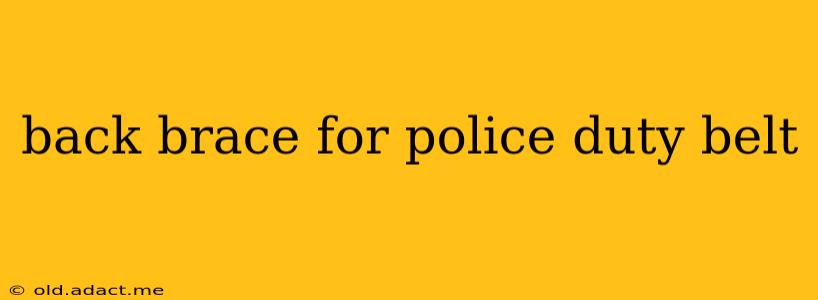Police officers face demanding physical challenges daily. Carrying a heavy duty belt laden with equipment contributes significantly to back strain and potential injuries. This comprehensive guide explores the crucial role of a back brace in mitigating these risks, examining different types, features to consider, and how to choose the right support for your needs.
What are the Benefits of Using a Back Brace with a Police Duty Belt?
Wearing a back brace while carrying a heavy duty belt offers several significant benefits, directly impacting an officer's physical well-being and job performance. These include:
- Reduced Back Pain: The most immediate benefit is the reduction of lower back pain caused by the weight of the duty belt. A good brace provides support and helps distribute the weight more evenly across the back, preventing strain on the spine.
- Improved Posture: Many braces promote better posture, helping officers maintain a more upright and balanced stance, reducing the risk of slouching and associated spinal problems.
- Increased Stability: A back brace offers increased stability, minimizing the risk of sudden movements or awkward postures causing injury. This is particularly crucial during high-stress situations.
- Enhanced Mobility: While seemingly counterintuitive, proper support can actually enhance mobility by reducing pain and stiffness, allowing for greater flexibility and ease of movement.
- Injury Prevention: The long-term preventative effects are invaluable. By reducing strain and promoting proper posture, a back brace significantly lowers the risk of developing chronic back problems and debilitating injuries over a career.
What Types of Back Braces are Available for Police Duty Belts?
Several types of back braces can effectively support officers while wearing their duty belts. Understanding the differences is crucial for making the right choice:
- Lumbar Supports: These provide targeted support for the lower back, focusing on the area most affected by the weight of the duty belt. They are often lightweight and discreet, fitting comfortably under a uniform shirt.
- Sacroiliac (SI) Joint Supports: For officers experiencing pain in the SI joint (where the pelvis and spine connect), these braces offer targeted support to this specific area.
- Full Back Supports: Offering more comprehensive support, these braces cover a larger area of the back, providing greater stability and weight distribution. They are generally more rigid and structured than lumbar supports.
- Adjustable Braces: These are designed to be tailored to individual body shapes and sizes, ensuring a comfortable and effective fit. Adjustability allows for fine-tuning the level of support as needed.
What Features Should I Look for in a Police Back Brace?
When selecting a back brace, several key features should be considered to ensure optimal support and comfort:
- Breathability: Look for breathable materials to prevent overheating and discomfort, especially during extended periods of wear.
- Adjustability: Adjustable straps and closures allow for a customized fit, ensuring the brace stays in place and provides effective support.
- Durability: A durable brace is essential for withstanding the rigors of daily police work. Reinforced stitching and high-quality materials are key indicators of durability.
- Comfort: Comfort is paramount. A poorly fitting or uncomfortable brace will likely be neglected, negating its protective benefits. Consider padding and materials for comfort.
- Weight: While support is crucial, excessive weight can be counterproductive. Strive for a balance between support and lightness.
How Do I Choose the Right Back Brace for My Needs?
Choosing the right back brace involves considering several factors:
- The severity of your back pain: If you have pre-existing conditions, consult a doctor or physical therapist before purchasing a brace.
- Your duty belt weight: Heavier belts require more robust support.
- Your body type and size: Ensure a proper fit to maximize effectiveness and comfort.
- Your budget: Back braces range in price from affordable to more specialized models.
Does wearing a back brace impact my ability to draw my weapon?
This is a critical concern. Choose a brace that allows for full range of motion and doesn't impede quick access to your firearm. Test the brace thoroughly to ensure it doesn't hinder your critical tactical movements. Experiment with different styles to find one that doesn't interfere with your draw.
Can I wear a back brace under my uniform shirt?
Many lumbar support braces are designed to be worn discreetly under a uniform shirt. However, larger, more structured braces may be more visible. Consider this factor when choosing a brace, balancing support with discretion.
What is the difference between a back brace and a support belt?
Support belts typically offer less structured support than back braces. Back braces usually feature more rigid components and provide greater stability, especially beneficial for carrying heavy loads. Support belts can be a good option for milder back pain or as a less noticeable alternative, but for significant weight, a brace is typically recommended.
By carefully considering the factors outlined above, police officers can choose a back brace that effectively supports their duty belt, protecting their backs and ensuring peak physical performance throughout their careers. Remember, prioritizing back health is crucial for a long and healthy career in law enforcement.
